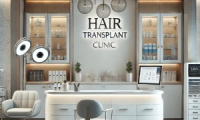
My Hair UK London Clinic
United Kingdom
20 employees
Established in 2020
Company description
See translation
Patients experiencing androgenetic alopecia (AGA) in London often face three main treatment routes: Platelet-Rich Plasma (PRP), Low-Level Laser Therapy (LLLT), and hair transplantation. Each option differs in its mode of action, degree of invasiveness, cost, and expected outcomes. Choosing the right path depends on your stage of hair loss, medical background, and treatment goals. PRP therapy involves isolating concentrated platelets from a small volume of your own blood. These platelets contain growth factors which, when injected into the scalp, can improve hair follicle survival and promote regrowth. A growing number of studies support its effectiveness in early-stage AGA. A 2024 systematic review published in Dermatologic Therapy found consistent improvement in hair thickness and density in PRP-treated patients with AGA, particularly in women. Another trial in 2023 concluded that PRP delivered “satisfactory” outcomes in men with pattern baldness, when performed in repeated sessions over several months. In London, PRP costs typically fall between £300 and £700 per session. A standard course often includes three initial monthly sessions followed by maintenance every few months. While not permanent, PRP remains appealing due to its minimal invasiveness and short recovery. Low-Level Laser Therapy (LLLT) uses wavelengths of red or near-infrared light, typically around 650 nm, to stimulate epidermal stem cells in hair follicles. This photobiomodulation increases ATP production, improves follicular metabolism, and may prolong the anagen (growth) phase of hair. A 2022 meta-analysis in Lasers in Medical Science found that LLLT significantly increased hair density compared to sham treatments, with a good safety profile. Earlier studies also supported LLLT use in both male and female pattern hair loss. LLLT is commonly delivered via in-clinic machines or home-use devices like helmets and caps. Session frequency is usually 3–4 times a week for at least 16 weeks. The upfront cost of home-use LLLT ranges from £200 to £1,000. In-clinic treatments may be higher depending on the protocol and clinic reputation. Results may be modest, but consistent use often leads to improved density in the crown and mid-scalp over time. Hair transplantation, particularly using the Follicular Unit Extraction (FUE) technique, remains the most definitive solution for hair loss. The procedure involves extracting grafts—tiny groups of 1–4 hairs—from a donor area (usually the back of the scalp) and reimplanting them into bald areas. It is a surgical procedure requiring local anaesthesia, skilled technique, and postoperative care. A 2022 clinical review published in Aesthetic Plastic Surgery supported FUE as a highly effective approach for patients with established pattern hair loss and adequate donor supply, noting low complication rates and high graft survival. Unlike PRP or LLLT, the effects are permanent, making it more appealing to patients with significant loss. Hair transplant prices in London vary widely generally ranging from £3,000 for a smaller session of around 1,000 grafts to over £10,000 for larger procedures. At My Hair UK, pricing is fixed: 1,000 grafts at £2,899, 2,000 grafts at £3,699, and 3,000 grafts at £4,499, with all prices including consultation and aftercare. It’s important to remember that no treatment suits everyone. If your hair loss is progressing rapidly, or if you have other symptoms like weight loss, fatigue, or scalp inflammation, it’s essential to rule out underlying medical causes first. Before starting PRP, LLLT, or considering surgery, speak to your GP to check for iron deficiency, thyroid dysfunction, or autoimmune disease. In central London, three reliable NHS GP surgeries where you can book a general health check are: The Bloomsbury Surgery, 1 Handel St, London WC1N 1PD Soho Square General Practice, 1 Frith Street, W1D 3HZ The Museum Practice, 58 Great Russell Street, London, WC1B 3BA These practices offer access to diagnostic blood tests and can refer you to a dermatologist or hair specialist if needed. Whether you choose PRP, LLLT, or a hair transplant, the first step is understanding your medical baseline. Investing time in proper assessment leads to safer, more effective outcomes.
 Sector / Industry
Sector / Industry{{industry.name}}
 Products and Services
Products and Services
{{pas.productName}}
HS code: {{pas.hsCode | limitTo: 23}}
HS code: {{pas.hsCode | limitTo: 23}}
Show more
Commercial information
Presence:
United Kingdom
Contact this company through Start-Up Nation Central
To get in touch with the ConnectAmericas support team, please send an e-mail with your request to soporte@connectamericas.com and we will get back to you briefly.
 This company is not yet verified
This company is not yet verified

Follow Us